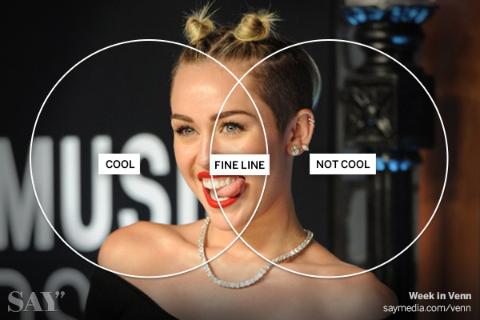What Makes a Brand Cool? - Say Media

"Miley stole the night, which is why the nation is still in recovery today."
-Rob Sheffield, Rolling Stone
By traditional marketing measures, Miley Cyrus' VMA performance was a huge success: it was one of the most tweeted events of the year, generating up to 306,000 tweets per minute and 4.5 million social media mentions, which is more than the blackout or the Super Bowl. Miley's just released new single jumped to the top of the Movers and Shakers list on Amazon on the news. And if you didn't know what twerking was before, you probably do now. But is any of this cool? There are so many potential ingredients for cool, and so many ways to get it wrong. Let's break it down…
Sometimes using the word "cool" can be cool. Sometimes it doesn't even mean cool. It's like that scene from Donnie Brasco when Johnny Depp defines shades of " fuggetaboutit." Cool can be fleeting, like this month's Perseid Meteor Shower . It can be reaffirming, like the recent NY Times outage which further legitimized that all the news that's fit to print might actually fit in the social stream. It can be generational, like a commercial using an 80's track to tap into a feeling and pry at your personal sense of vintage.
It can also be genre specific . Beer commercials may latch on to a new super wide mouth cold can to define cool. For them, it's about temperature, a faster less-burpy alcohol delivery, and bold verifiable claims. Car campaigns focus on sleek lines to elicit cool - it's about aesthetics and curb appeal. Fashion spots deliver denim with resonant music and celeb endorsements - it's about soundtrack and aspirational ass contour. It's cool, we can be honest.
When something is hot, it may not be cool. Hot oozes appeal. While one person's hot may be another's cool , hot requires kindling or it can easily burn out. When something hot remains vibrant and this phenomenon graduates to something sustainable, it might become cool. Cool, then, isn't about short-lived; it's about shelf life and consistency. Except for fireworks. Those are cool. Or that first kiss in fifth grade while you were listening to Guns N Roses' "Patience" for the first time despite sampling Cool Ranch Doritos a few minutes before (true story). The music was cool. The kiss was cool. The flavor was cool. The combination, though, was questionable. So maybe it's combinations that matter; not one specific thing but a mutual articulation that elevates. Something like Jay Z (no dash) and Justin Timberlake (dashing) on stage at Yankee Stadium. Super cool. Except for the reference to JT as "dashing." But he is, right? Cool.
So what are the ingredients of cool? Some scientists looked into it and according to their very real study, Coolness: An Empirical Investigation, social desirability and trendiness are key factors. But oddly, originality isn't mentioned. Apparently, it's not even a hard requirement for a trend, nor for something desirable. If anything, trends embrace mimicry. Many brands believe that uniqueness is the one crucial ingredient. Maybe not. Gatorade and Asics have near identical commercials in heavy rotation at present, but does this make either campaign less cool? Does this in any way diminish the power and pulp of Nike's 25th anniversary spot that strikes at the very same chord? Maybe showcasing an adherence to a pre-approved behavior/look/belief with some blend of improvisation is cool. Like music sampling a classic song to make a new one better. But then, when does emulation become infringement? And if you're set on following a trend, how can you ensure that the trend isn't merely a wish to be cool?
Is the legacy of cool a burden? The early millennium Apple switcher ads were seismic. Apple was once the little guy out-cooling the massive incumbent for market share. A decade later, Apple has become the seed for industry mocking, the focus of dissension and endless critique. So what can we deduce? Trying to be cool may not be, nor is overexposure; tipping points are real; early adoption has its merits as long as you understand there are more misses than hits; having something to say coupled with someone who listens to / acts upon / spreads the word is cool, as long as it's not out of hate or spite or malice.
So how can a brand get there? Half of wisdom is knowing your limitations. The other half is knowing when, where and how to ignore those limitations. It's a delicate balance, but when you solve for that, it can bepretty cool.
Doug Grinspan is Say Media's Vice President of Strategic Partnerships.
Say Media is a digital publishing company that creates amazing media brands. Through its technology platform and media services, Say enables its portfolio of independent content creators to build passionate communities around key consumer interest areas such as Style, Living, Food and Tech. For more information visit www.saymedia.com.
Read all Say Media's MediaBizBloggers commentaries at Say Daily.
Check us out on Facebook at MediaBizBloggers.com
Follow our Twitter updates @MediaBizBlogger
The opinions and points of view expressed in this commentary are exclusively the views of the author and do not necessarily represent the views of MediaBizBloggers.com management or associated bloggers. MediaBizBloggers is an open thought leadership platform and readers may share their comments and opinions in response to all commentaries.

